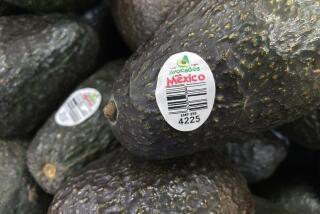Forces Mobilized in 3 Port Cities : FDA Inspectors Begin Chilean Fruit Checks
- Share via
LOS ANGELES — Less than a day after the Bush Administration lifted its embargo of Chilean grapes and berries, the federal Food and Drug Administration mobilized its field forces at three major U.S. port cities Saturday to begin the government’s stepped-up inspection program for fruit from that South American country.
At the Port of Los Angeles, FDA officials met with nearly 30 importers to offer guidelines on how to inspect their grapes. The new inspections are not expected to begin until Monday.
And at at least one Los Angeles market, a vendor did not wait for inspections and had returned grapes to the company’s shelves Saturday.
Most Fruit to Be Released
The new inspection system, announced by the FDA on Friday, will allow the release of the bulk of Chilean fruit now being held at U.S. ports. The largest component is 918,000 cases of grapes that will be placed on the market again after inspection.
But most grapes and berries that are already with wholesalers and retailers will have to be destroyed or exported to other countries. The FDA still has not decided what it will do with larger-sized tree fruits, such as nectarines, apples and melons. Industry leaders predict losses will total millions of dollars.
Most of the activity Saturday was taking place in Philadelphia, which receives more than half of all Chilean fruit coming to this country and where two red seedless grapes containing minute traces of cyanide were found last weekend. About 40 FDA supervisors and inspectors were teaching non-FDA workers how to examine grapes.
The workers, who included employees of the piers, the U.S. Department of Agriculture and the American Produce Assn., which represents the importers, will be responsible for conducting initial visual examinations of the fruit.
Bruises, Puncture Marks
Richard Davis, FDA regional director for the mid-Atlantic region, said experienced agency inspectors will watch over the new inspectors’ shoulders to see that they remove any moldy or mashed grapes or those with split skin, puncture marks or bruises.
Suspicious grapes that are pulled will then be examined by FDA personnel to determine whether they should be taken to the lab for chemical analysis, Davis said.
In Los Angeles, Lloyd Lehrer, a supervisor for the International Section of the FDA’s Investigations Branch, told importers they will have to arrange for 5% of their incoming shipments to be inspected. The inspection will have to touch all growers supplying fruit to the importer.
The importers at the meeting said they would spend the rest of the weekend drawing up detailed inspection plans that follow the government guidelines. The FDA will have to approve the importers’ plans early next week.
“Our only fear is that the process might be quite long,” said Rick Eastes, vice president of David Oppenheimer-California Inc., the West Coast’s largest importer of Chilean fruit.
“We’re ready to get back in business, to get fruit on the stands that people can feel good about,” he said.
At the Grand Central Market in downtown Los Angeles, at least one vendor, the Grand Fruit and Vegetable Co., has already restored Chilean grapes to the sales counter, according to employees. They said they believed the fruit to be safe.
In Philadelphia, FDA director Davis said he expected to train and deploy up to 300 inspectors by Monday. He said there would be some inspection this weekend, “because there is one ship unloading,” but that most of the ships will not unload cargo until “we get our staff organized,” probably Monday or Tuesday.
Miami Inspections
At the third major port, Miami, similar activity was reported under way.
In Washington, FDA Commissioner Frank E. Young said that most of the inspectors will come from the U.S. Department of Agriculture, but will also include “some industry people who are fruit sorters. We will be converting them into inspectors.”
The visual inspections will take place on 5% of the grape and berry cargoes now being held at ports, a substantially higher proportion than has been inspected since two threats were telephoned to the U.S. Embassy in Santiago, warning that Chilean exports destined for the United States would be poisoned.
But Young said Saturday he could not predict how long inspections would remain at that level. “The more we go along the way, the higher the confidence level,” he said.
Young again emphasized that the system could not guarantee 100% safety and that consumers themselves should be especially vigilant in examining the fruit they buy, looking especially for accelerated ripening, which can be caused by cyanide.
There were signs, however, that much of the crisis fears had abated. Young, who was working nearly round the clock this week, spent Saturday morning at the zoo with his granddaughter.
Marlene Cimons reported from Washington and Tracy Wilkinson from Los Angeles.
More to Read
Sign up for Essential California
The most important California stories and recommendations in your inbox every morning.
You may occasionally receive promotional content from the Los Angeles Times.














